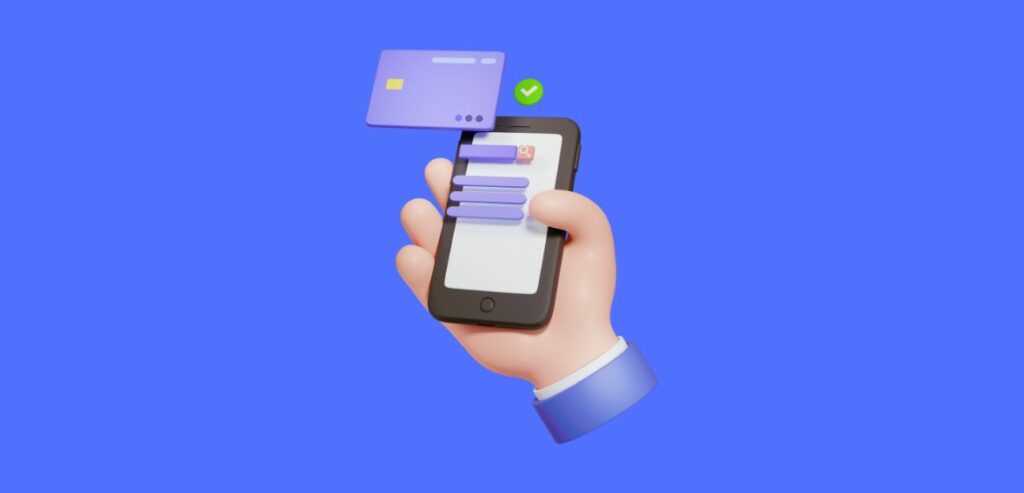A few months into 2024, we’ve already witnessed a surge of innovations enhancing customer experiences, with Tap-to-Mobile, also known as Tap-to-Pone, technology standing out prominently. This advancement transcends traditional POS systems and recent handheld terminals by transforming any compatible smartphone into a fully functional POS system. This alleviates the limitations and security concerns associated with conventional POS setups and significantly enhances a business’s bottom line.
Tap-to-Mobile allows merchants to conduct transactions virtually anywhere—an indispensable capability whether at a remote site, a customer’s home, or anywhere within their store—requiring only an Android device and an internet connection. Globally, retailers are embracing mobile payment solutions, vastly improving their operational flexibility and customer service capabilities.
Understanding What Exactly is Tap-to-Mobile
Tap-to-Mobile or Tap-to-Phone technology revolutionizes retail payments by enabling a seamless checkout process. This method allows any smartphone or tablet equipped with NFC (Near Field Communication) to process contactless payments directly, eliminating the need for traditional, expensive payment terminals. Retailers use their mobile devices to accept payments, with customers just tapping their credit card or NFC-enabled device on the retailer’s phone or tablet to complete the transaction.
With over 3 billion NFC-enabled smartphones globally, or 20% of the worldwide population utilizing NFC technology, the surge in interest from the industry and fintech companies is understandable. This technology is seen as a natural progression in simplifying payment systems and lowering entry barriers for merchants.

Source: NFC Forum
How to Use Tap to Mobile?
To utilize Tap to Mobile technology, you only need an NFC-enabled smartphone. Users install a ” Terminal ” application on their device, eliminating additional hardware requirements.
Here’s how to make a payment with Tap-to-Phone:
- The seller enters the transaction amount in the app.
- The buyer taps their card or NFC-enabled device into the seller’s smartphone.
- The app processes the payment.
- The seller issues an electronic receipt to the buyer via email or SMS.
Contactless payments via your smartphone are as secure as transactions conducted through a physical POS terminal. Payment information is safeguarded through a secure network that encrypts credit card details, ensuring the transaction remains protected. Importantly, the seller cannot access the customer’s card information.
Where is Tap to Mobile Applicable?

Tap to Mobile is a versatile, cost-effective, and scalable payment solution perfect for small to medium-sized businesses or operations with mobile venues. It allows you to effortlessly accept contactless payments directly on your phone, facilitating a no-touch payment process.
For businesses offering curbside pickup, Tap to Mobile lets customers quickly pay for their orders on the spot, eliminating any physical contact. Additionally, if your business provides pay-on-delivery services, customers can conveniently tap their card or device to pay at their doorstep, avoiding the need for cash and minimizing contact. This is especially beneficial considering health and safety concerns from the pandemic.
These “smartphone” terminals are particularly well-suited for:
- Traveling Sales: Employees on the road require fast, convenient, and secure ways to complete transactions immediately after sales pitches. With Tap to Phone, they can finalize sales instantly without needing additional payment accessories.
- Line Busting: Long queues can frustrate customers and tarnish a store’s reputation. Tap to Mobile offers a digital solution that retains customer footfall and enhances the shopping experience by allowing payments anywhere within the store, easing long wait times and maintaining high security.
- Pay at Table: Restaurants can enhance the dining experience by equipping servers with devices capable of Tap-to-Mobile technology, facilitating immediate bill settlements, increasing table turnover, and ensuring a smooth dining experience.
- Delivery Services: Delivery personnel can easily accept contactless payments via Tap to Mobile, eliminating the need for customers to have cash ready for payments or tips.
- Pop-ups: Online direct-to-consumer (DTC) brands hosting pop-ups or small stores can leverage Tap to Mobile technology to save space and simplify logistics by replacing traditional payment hardware.
- Food Trucks: Food trucks utilizing Tap to Mobile can reduce their reliance on cash transactions, facilitating quicker and safer payment processes.
- Insurance Agents: Insurance agents can use Tap to Mobile to accept premium payments on-site during client visits, providing convenience and improving payment collection efficiency.
- Small and medium-sized businesses: Tap to Mobile technology empowers small and medium-sized businesses to accept payments efficiently without investing in expensive POS systems, making managing cash flow and customer interactions easier.
- Courier delivery services: For courier services, Tap to Mobile enables drivers to accept payments upon delivery, enhancing customer convenience and ensuring secure, immediate payment for the service provided.
- Taxi drivers: Taxi drivers can use Tap to Phone to accept fare payments from their mobile devices, speeding up the payment process and providing passengers with a smoother and more modern travel experience.
While physical POS terminals are more appropriate for businesses that handle a high volume of transactions in a brief period, such as supermarkets and retail chains, POS terminals are typically faster as they are dedicated solely to processing payments. Tap to Mobile helps as an addition to reduce waiting times in queues at your store. Customers can quickly complete their transactions, allowing you to handle more orders and boost sales.
Benefits of Tap-to-Mobile Technology

Tap on Mobile is revolutionizing payment processes for businesses, particularly in emerging markets, by significantly lowering payment costs. This technology eliminates costly investments in purchasing and maintaining traditional payment terminals (dataphones). It’s also an attractive option for pure eCommerce retailers who occasionally need to accept in-person payments.
Large retail chains can also benefit from incorporating Tap on Phone into their existing services, such as clienteling, to enhance the overall payment experience. For these larger setups, it’s crucial to integrate the mobile POS system currently in use with the chosen Tap on Phone application, ensuring seamless operation within the store’s existing software framework.
Here are some key benefits of adopting Tap to Mobile technology:
- Elimination of External Hardware: Tired of bulky payment terminals? With new regulations allowing PIN entry on touchscreens, businesses can now process payments directly on their smart devices. Tap to Mobile technology frees up valuable desk space and integrates seamlessly into daily operations.
- Effortless Setup: The absence of physical POS terminals significantly simplifies the setup process. Merchants need only download an app from their payment provider and follow straightforward onscreen instructions. Once set up, they can start processing transactions immediately.
- Minimal to No Startup Costs: This payment method cuts the time and expense of traditional terminal setups. It also facilitates faster transactions at checkout and curbside service, enhancing customer convenience.
- Instant Payment Processing: By collaborating with a payment processor, merchants can quickly, conveniently, and securely handle card payments. A recent survey revealed that only 16% of consumers consistently carry cash, while most prefer using credit or debit cards or digital wallets. As cash usage declines, merchants must support card and mobile wallet payments. Tap to Mobile represents a significant advancement in the global shift toward a digital payments ecosystem.
Which Smartphones Have NFC?

The number of devices equipped with NFC is continually increasing. Nowadays, it’s often simpler to identify which phones lack NFC support.
Virtually all contemporary Android devices come with NFC, as do all iPhones from the iPhone 6 onward. However, a relatively recent Android or iOS version is required to fully utilize the latest NFC features. For example, the iPhone 6, which only supports up to iOS 12, misses out on newer NFC functionalities introduced in iOS 13, such as Digital IDs and keys, which need at least iOS 15. On the Android side, although version 4.4 introduced Google Pay, the most up-to-date NFC security features require Android 10 or newer.
Nevertheless, both Android 10 and iOS 13, released in 2019, are compatible with most smartphones produced since at least 2017. This means nearly any phone manufactured in the last seven years should be capable of full NFC functionality.
How Can You Accept Payment on Your Smartphone?
To transform your phone or tablet into a dataphone capable of accepting card payments, a few key steps and conditions are necessary:
- NFC-Enabled Device: Your smartphone must have NFC capabilities. This is essential as NFC technology facilitates the contactless communication required for Tap to Mobile payments.
- Downloading an App: Install a dedicated Tap to Mobile application from your payment provider. For example, platforms like Visa’s Tap to Mobile and others available on app stores allow for such capabilities. Each provider will have its own set of functionalities and supported payment methods. Other than Visa, there are many options, which include major payment networks and companies such as Viva Wallet, MasterCard, Vibrant, Paytweak, and SumUp.
- Internet Connection: An active internet connection is needed to process payments. This ensures that transactions can be verified and processed in real time.
- Provider and Region-Specific Requirements: Depending on your location and the specific app you choose, additional requirements like registering your business officially or complying with local financial regulations may exist. The number of available providers is expanding, and retailers must enter into agreements with these providers to handle payment processing and software usage.
Conclusion
Tap-to-Mobile (Tap-to-Phone) technology emerges as a transformative force in the payment industry, offering unparalleled flexibility and security while revolutionizing the checkout experience. By enabling merchants to accept contactless payments with just a smartphone or tablet, Tap-to-Mobile eliminates the need for traditional payment terminals, reducing costs and streamlining operations. Its versatility makes it applicable across various industries, from traveling sales to restaurant dining and courier services.
Plus, the benefits of Tap to Mobile extend beyond convenience, with minimal startup costs, effortless setup, and instant payment processing enhancing both customer experience and business revenue. With the widespread adoption of NFC-enabled smartphones and the continuous evolution of mobile payment solutions, Tap to Mobile stands as a cornerstone in the transition toward a digital payments ecosystem, empowering businesses of all sizes to thrive in an increasingly cashless world.
Frequently Asked Questions
What is Tap-to-mobile?
Tap to Phone is a contactless payment technology that enables merchants to use their NFC-enabled smartphones or tablets as payment terminals, accepting payments from contactless cards and mobile wallets.
How does Tap to Mobile work?
Merchants download a compatible app on their NFC-enabled device. Customers tap their contactless card or NFC device near the merchant’s smartphone to make a payment, which is securely processed through the app using NFC technology.
Is Tap to Phone secure?
Yes, Tap to Phone is secure. It employs standard payment protocols, encrypting payment information via NFC technology. Additionally, PCI security standards set strict requirements for developers, ensuring transaction security.
What are the benefits of Tap to Phone for businesses?
Tap to Phone is cost-effective, eliminating the need for traditional point-of-sale hardware. It’s convenient for mobile businesses, allowing payments anywhere. It offers customers a quick and seamless payment experience, potentially enhancing satisfaction.

